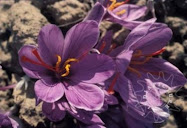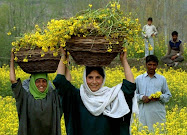 Hari-Parbat or only Parbat as it was fondly called has been since time immemorial a very fond attraction for the KPs especially of Srinagar. An old legend says that the place was a large lake inhabited by a ferocious demon Jalobhava. In order to save the valley from the demon Sati Mata the royal consort of Mahadeva took the form of a bird (Haer in Kashmiri) with a small pebble in its beak. She dropped it on the head of the demon and the miracle that ensued was that the stone enlarged rapidly and took the shape of present Hari-Parbat and the demon was crushed under it.
Hari-Parbat or only Parbat as it was fondly called has been since time immemorial a very fond attraction for the KPs especially of Srinagar. An old legend says that the place was a large lake inhabited by a ferocious demon Jalobhava. In order to save the valley from the demon Sati Mata the royal consort of Mahadeva took the form of a bird (Haer in Kashmiri) with a small pebble in its beak. She dropped it on the head of the demon and the miracle that ensued was that the stone enlarged rapidly and took the shape of present Hari-Parbat and the demon was crushed under it.The hill thus formed in place of the lake became the abode of numerous Gods and goddesses and particularly the shrine of Chakhrishur on its western face where Mata Tripursundari Sharika is seated graciously represented by the self made Srichakra engraved on a vertical holy rock (Shila). Number of holy temples representing various deities is located on all sides of the hill. So as a devotion to all these deities the devotees circumambulated the hillock to get their desires fulfilled. The Parikrama starts from the Lord Ganesh’s Shrine, which is located on the south-western corner. Inside the temple the deity is represented by a huge Shila. The next place of obeisance on the Parikrama route is the Saptrishi-Sthapna (Satresh) which is marked by an open space on the slope of the hillock near a big boulder in the vicinity of a Chinar tree. Here, the devotees ascertain their luck (locally known as Phal) by random picking up of some rice grains scattered on the boulder.
There are two Parikrama routes, one along the foot-hill of the hillock and the other along the fortified stone wall. The devotees have the option of taking either of the two. Further on, the next holy spot on the Parikrama is the shrine of Goddess Kali, which is marked by a small temple adjacent to a Chinar tree with a large flat open space in front known as Sidh-Peeth-- a place of lively divine presence. The shrine is said to be invested with very strong divine vibrations.
An old fort on its top built by Mughal Emperor Akbar exists there with ruins of a tall strong stone wall around the hill called Kallai in local dialect with ruins of two magnificent gates, Sangeen Darwaza and Kathi Darwaza. The wall enclosed an old populous city with the King’s palace along with the royal armory on its top. The view of Dal Lake and a part of the valley from the fort is most fascinating. Just near the southern side of the outer wall there is Gurdwara Chati-Padshahi which commemorates the visit of the Sikh Guru Shri Hargobind Singh Sahib.
Pokhribal, the shrine of the mother Raghnya is another holy spot on the Parikarma route. The holy spring inside the temple complex is the attraction of thousands of devotees.With the displacement of Pandits outside valley Hari-Parbat and lots of other important Hindu shrines in Kashmir seem in a state of neglect as most of them are guarded by security forces that’re unaware about the importance and sanctity of these places. It’s unfortunate that Kashmir, once a proud face of the Hindu India is changed altogether with its essential Hindu flavour missing now that was once its essential ingredient and none of the concerned neither the administration nor the people of this great country raise even a single voice against this great human tragedy.
.jpg)




My goodness the Hari Parbat can serve as such a great example of secularism looking at its history.I wonder when will we stop stooping to conquer-which is the case of Kashmir.With KPs out of Kashmir the essence of Kashmiryat in Kashmir is lost,although I sincerely pray that the day is not far when this essential shoot goes back to its root.And let us together garner public support for this cause.Although through this space we have taken a step forward.
ReplyDeleteWherefrom did the unduly battered term secularism crop-in? Hari-Parbat is the abode of 33 crore gods of the Hindu pantheon and a leading living symbol of pre-historic Hindu Kashmir while the existing fort on its top along with the ruins of the stone wall around it is a recent development of late sixteenth century built by a Muslim king. The displacement of more than four lack Pandits the sole descendents of the glorious past of Hindu Kashmir under the fear of gun in early nineties is the worst tragedy of this century and the criminal silence of the millions of the Hindus of India and their leaders is equally tragic.
ReplyDeleteWell Secularism is a term very close to my heart so it crops up again and again.thanks to my liberal upbringing.I still feel no matter how many Hindu gods abode this place,the fact that today it houses a fort built by Akbar as well as a gurudwara it gives it a secular fervour.And I dont believe in building narrow walls of caste,creed,religion,race around anything no matter what the History has been as we need to be progressive not retrogressive to surge ahead.
ReplyDeleteI suggest closing this discussion here and concentrate on the real purpose of my posts i.e. highlighting the essential characteristics of Kashmir culture especially for the benefit of KP youth who’re distancing themselves from it day by day being away from their roots.
ReplyDeleteHistory is made up of a chain of events interconnecting each other and Secularism is where everybody respects each others views/thoughts/religion,etc. So,I suppose things keep changing; there are additions & subtractions, maybe for the GOOD or BAD, which should be for the individual to decide.
ReplyDeleteSuch an informative post about the Hari-Parbat or only Parbat as it was fondly called has been since time immemorial a very fond attraction for the KPs especially of Srinagar.Get the Kashmiri Heritage online
ReplyDelete